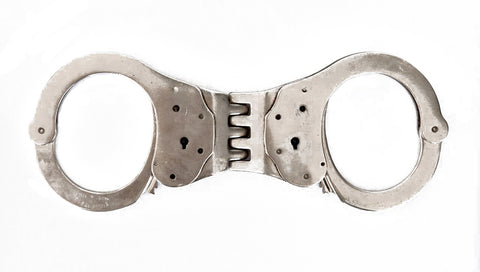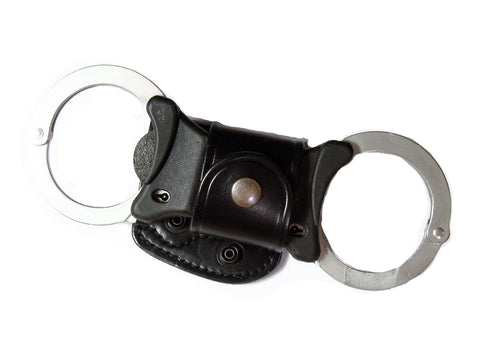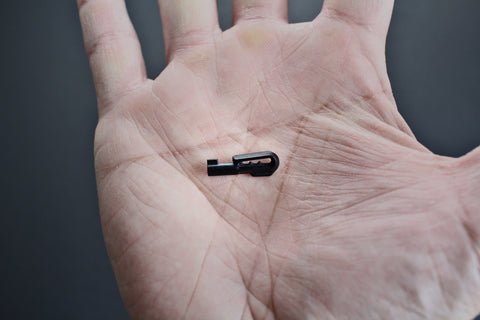The modern standard of handcuffs is the design popularized by Peerless in the early 1900’s, with few alterations since then. Most handcuff brands now bear a similar design, with only minor variances amongst the locks themselves. The design is known as a swing cuff, which features a freely swinging ratchet arm that allows law enforcement to secure the cuffs with just one hand, improving speed, agility, and safety. The most significant differences between handcuffs are found in the way the cuffs connect.
Chain Handcuffs

Chain handcuffs are the most widely used among law enforcement for everyday arrests due to their ease of application. The two cuffs are attached by a short chain, just one or two links long. This chain allows the cuffs to be folded in half for improved portability. The ratchet arms on chain cuffs are usually swing-through for ease and speed of application: they can be applied to the subject’s wrist with just one hand.
Hinged Handcuffs

Hinged cuffs are very similar to chain cuffs, but they are connected with a large hinge rather than chain links. Hinged cuffs are shorter than chain cuffs when extended, which allows for less hand/arm mobility. This makes hinged cuffs potentially more secure, but somewhat more difficult to apply to a testy subject. Many law enforcement officers find that the solution to this problem, if one wrist has been cuffed but the subject is non-compliant, is the ability to apply uncomfortable torque on the cuffed wrist as a method of persuasion. The hinge adds some overall strength to the cuffs as well. Though it’s very rare, the occasional Hercules (probably somebody on drugs) may be able to snap the chain links between traditional handcuffs, but with hinged cuffs on he’s going nowhere. Like chain cuffs, hinged cuffs can be folded in half.
Solid Bar Handcuffs

Solid bar handcuffs provide the same level of tamper-resistance as hinged handcuffs and even less mobility, but they come with the caveat of being harder to carry because they cannot be folded in half. Their appeal lies in the ability for an officer to apply pain-compliance techniques. Handcuffs connected with a solid bar are most likely to be used for prisoner transport of individuals who are known to be non-compliant.
Waist Chains

Though not technically a type of handcuffs by themselves, waist chains are worth noting here for the added security they bring. The purpose of a waist chain is to further reduce a subject’s mobility. They are unable to bring their hands higher or lower than their belly, thus preventing violence and tampering.
High Security Handcuffs
High security handcuffs can take the form of any of the three basic types of handcuffs listed above. The primary difference is that high security handcuffs cannot be opened with a standard barrel-shaped universal handcuff key. High security handcuffs are keyed individually and are more pick-resistant than their lower security counterparts. Some high security cuffs include an additional locking position to increase the security of the double lock.
Basic Escape & Evasion Methods
A pair of swing cuffs can easily be placed with one hand with a little practice, but handcuffs still need to be placed properly to avoid tampering or escape. Handcuffs placed in front make it much easier to attempt to pick the lock or open them with a universal handcuff key. If you are handcuffed unlawfully, you need to be aware of the following methods of escape.

Hand Positioning
Escaping from handcuffs is very difficult if your hands are behind your back whether you’re using a handcuff key or another means of escape, so do everything possible to ensure that your hands are in front of you. If your captor insists that your hands be behind you, try the following maneuver:
Sit or lie down and fold your legs and feet as close to your body as possible.
Pull your hands down, under your feet, and up to the front of your body. You’ll be in a better position to perform this maneuver if you keep your body flexible and in good shape.
Practice this regularly if you are in a line of work or often find yourself in situations where being unlawfully detained is a threat.
Once your hands are in the front, produce your handcuff key (if you keep it on your back belt loop, you’ll want to grab it while your hands are still behind your back). Insert the key as far as you can into the keyhole. With a firm grip turn the key clockwise, just far enough to disengage the locking mechanism.
Pick the Lock
Because the ratchet & pawl mechanism of most modern handcuffs is simple by necessity, picking a handcuff lock is a pretty simple maneuver. This doesn’t mean you don’t need to practice, a lot. In a tense situation you’ll largely be relying on muscle memory.
Most handcuffs can be unlocked with a single universal handcuff key. Because most types of cuffs can be unlocked with the same key, they can also be picked in much the same way. All you need is a very thin length of wire, and patience.
Keep in mind that this will be much easier if your hands are in front of you. If you are using a bobby pin, straighten it and remove the rubber cap on the end. If using a paperclip, straighten it. It’s wise to keep a prepared bobby pin or other length of wire on your person so you’re not fumbling with getting it ready in the moment.
Bend the end into roughly a 90 degree angle- the easiest way to do this is by inserting the pin or clip halfway into the upper portion of the lock and bending it. This will allow you to wiggle the wire into the lock and apply tension in the appropriate place.
Insert the newly-bent pick into the upper portion of the lock, the curved portion of the pick heading toward the center of the cuffs. Apply enough tension to release the lock. The wire is mimicking a handcuff key pressing against the locking mechanism.
Shimming
A shim is any small, flat piece of metal about the width of a credit card and narrow enough to fit into the locking mechanism. You can purchase pre-made shims that look very similar to a handcuff key, or even create one from a length of cut soda can. Insert the shim in between the locking mechanism and the teeth. Push on the shim and tighten the cuff a single notch. The cuff should unclick. (This method will not work if the cuffs are double locked.)
Preferred Method: Use a universal handcuff key

The surest method of escaping handcuffs is with a universal handcuff key. Using a handcuff key removes the stress and guesswork of trying to use a shim or pick the lock with wire. You’ll want a handcuff key with an easily-concealable design- a key you can clip onto your clothing or gear is ideal. A tiny inconspicuous handcuff key is a valuable addition to any survival toolkit.
When Can You Be Legally Handcuffed?
Ask the average law-abiding American citizen when they can be placed in handcuffs legally and you’ll probably be met with a blank stare, followed by “uh, when you break the law?” Naturally, it isn’t always as black-and-white as that.

When you decide to keep a handcuff key on your person for a SHTF event, the possibility of societal collapse, and everyday preparedness, it’s essential that you know your rights. The following are situations in which you can be legally handcuffed by law enforcement. We do not advise attempting to escape in these situations, even if you question the legality of your detainment. If you feel that your civil rights have been violated, contact a civil rights attorney.
The primary law to be aware of is the fourth amendment, which prohibits unreasonable searches and seizures and requires any warrant to be judicially sanctioned and supported by probable cause. We could take pages and pages discussing what warrants an “unreasonable” search or seizure; ultimately that will be up to the officer in the moment and is likely to vary from person to person. With this in mind:
- Law enforcement can handcuff you while executing a warrant.
- Law enforcement can handcuff you without reading you Miranda rights; these apply only to interrogations.
- Law enforcement can handcuff you when they perceive your behavior as a threat to their safety. The criteria here is not rigid. It’s impossible to anticipate every possible situation when handcuffs would be necessary or advantageous. You can bet that any verbal or physical threat toward an officer will result in handcuffs at the very least.
- Law enforcement can handcuff you at any time while you are in their custody. In other words, if you’ve been arrested you can be cuffed at any point during that process, even if your cuffs had previously been taken off.
According to a training bulletin from the Los Angeles Police Department:
“The principle reason for handcuffing an arrestee is to maintain control of the individual and to minimize the possibility of a situation escalating to a point that would necessitate using a higher level of force or restraint. The decision to use restraining procedures and devices depends on common sense and good judgment.”
Law enforcement can make a case that any of the above situations warranted handcuffing you.
What About Citizen’s Arrest?
Citizen’s arrest began as a common law that allowed for citizens to make a warrantless arrest for crimes such as prostitution and gambling. Most states have since codified those common laws, and they vary widely by state. All states require that a citizen can only legally arrest an individual if the crime happened in their presence. This extends to merchants, who enjoy in most states the ability to detain a suspected shoplifter until law enforcement arrives.
A handcuff key is an important part of your everyday carry, but should not be used when you have been detained by law enforcement, especially considering the lack of rigidity surrounding the legality of detainment. It will be easier for an officer to defend their choice to handcuff you than it will be for you to defend your choice to escape custody. It is much wiser to seek professional legal counsel if you feel your civil rights have been violated.
All About Disposable Restraints
As many of our loyal customers have pointed out to us, a handcuff key will be of little use if you find yourself tied up in disposable restraints. Read on to learn all about disposable restraints, the circumstances in which they are often used, and some tips for escaping unlawful detainment.
What are They?
A disposable restraint can be an extremely effective tactic, yet as simple as a single zip tie. Zip ties come in different units of “tensile strength”, which is the maximum stress they can withstand before failing. A standard nylon tie sold for the purpose of detainment (such as a Flex-Cuf) will likely have a tensile strength of anywhere between 300-600 pounds. (Cable ties sold at your local hardware store will be tough, but likely with a lower tensile strength.) These cuffs come in two types: a single length of cable that is wrapped around both wrists, or a set that looks more like traditional handcuffs with a separate loop and lock for each wrist. Zip ties function with the same ratchet mechanism as standard handcuffs, the difference being the absence of a lock and key.

Silverxxx / Wikimedia Commons / CC-BY-SA-3.0 / GFDL
Where Are They Used?
Disposable restraints are most often seen when law enforcement anticipates a high number of arrests that renders metal cuffs impractical, such as riots or demonstrations. They are cheap, lightweight, and easy to carry in bulk, which makes them ideal for detaining a large number of individuals at once. They can also be more easily attached to one another than metal cuffs, which allows an officer to easily contain a group of detainees if working alone. Zip ties are also a common restraint of choice for those with more sinister motives, for the same practical purposes: cheap, quick to use, and lightweight, not to mention easily concealable.

helloturkeytoe / CC BY 2.0
Escaping
Should you find yourself unlawfully restrained with plastic cuffs, rest assured that with a little practice and resourcefulness, there are several ways to escape them. The effectiveness of these tactics will depend on the material type and thickness as well as the positioning of your hands and what tools you have at your disposal.
-Brute force: by tightening the cuffs as much as possible and then bringing them down hard against your body, it is possible to snap the cuffs.
-Melting: a flame or cigarette lighter may be able to melt the plastic, weakening it enough for you to pull the cuffs apart (preferably before burning yourself).
-Sawing: a sharp serrated edge may be able to saw through the material, if you can position your hands correctly or rub them against the tool.
-Shimming: because zip ties operate with a ratchet mechanism, you can shim them in the same way you may shim standard metal cuffs that haven’t been double locked.
Check back next month for a more in-depth study of disposable restraint escape methods.
If you are familiar with today’s standard-issue handcuffs, you know that most models, even across different brands, can be opened with a universal key. A universal handcuff key at first seems like a very counter-intuitive concept, placing law enforcement at a tactical disadvantage. But consider which scenario is really of a greater disadvantage- one in which the cuffs being used to secure a suspect can be opened by a universal key, or one in which the cuffs can only be opened by a single unique key, easily misplaced or lost?
Universal handcuff keys have a simple barrel shape, popularized in 1932 by Peerless Handcuff Co. with the introduction of an updated cuff design. At the end of the barrel is a single small tooth, which is turned to disengage the lock mechanism. The simplicity of the design is intentional: the hassle of requiring a different unique key for every single pair of handcuffs used would slow down the process unnecessarily; a suspect may enter the custody of many different officers from initial detainment, to prisoner transport, to the moment when the cuffs are removed. A universal key allows for a much more seamless transition that ultimately works in the favor of all involved, including the suspect.

Naturally a universal locking mechanism can present the potential for unlawful escape attempts. Law enforcement works to prevent this from happening in a variety of ways- among them are thorough searches of the suspect, proper handcuff positioning to make it more difficult to tamper with the cuffs, and employing the double lock. There is a secondary advantage to the uniformity of handcuff keys, however, and that is the ability to escape should you become wrongfully detained. With its unprecedented ease of concealment, a covert handcuff key is the perfect solution for such a scenario.
As quick and simple as it is to secure most modern cuffs on an individual (with a pair of swing cuffs it can easily be done with one hand), there is quite a bit of technique that law enforcement officers must learn in order to place handcuffs most efficiently. The primary goal of cuffing a suspect is to restrain their hands (at the very least) so that they can be dealt with lawfully. Quality cuffs placed in just about any position will effectively provide some level of restraint, but an LEO must also consider the possibility that the suspect may try to escape, and cuff them accordingly without an extreme degree of discomfort for the suspect.
Handcuffs placed in front make it much easier for a suspect to attempt to pick the lock, open them with a universal handcuff key or even use their hands and arms as a weapon. An officer’s first line of defense, then, is to cuff the hands behind the back. Police recruits are typically taught to apply cuffs so that the palms of the suspects’ hands, already behind their back, face outwards with the thumbs up. This makes it more difficult for the hands and fingers to work together to pick or otherwise escape from the cuffs.

A concern, however, of this standard of hand placement is the possibility of handcuff neuropathy. Handcuff neuropathy is the occurrence of numbing, tingling, burning, or pain sensations in the suspects’ hands as a result of nerve compression from the cuffs. Handcuff neuropathy occurs in varying degrees, but if severe enough can be rather debilitating and long-lasting. One way officers may choose to lessen this possibility is by placing the palms together (still behind the back). This somewhat increases the ease with which the suspect may tamper with the lock, so the officer will likely also position the cuffs with the keyholes facing up and away from the hands. This makes the cuffs more difficult to open, even with a covert handcuff key.
A particularly motivated individual may attempt to slip their hands over their feet and legs in order to bring their hands to the front and into a better position to tamper with the cuffs. If this is a concern, a law enforcement official may choose to secure the cuffs, via zip ties or a carabiner clip, to the back of the suspects’ belt or belt loop. Belly chains are another option, often used when transporting high-security prisoners.
It’s impossible to trace back through history to the very first appearance of handcuff-like restraints. After all, as long as humankind has been around there has been the necessity to restrain some less-than-savory characters. Before metal handcuffs, of course, people used rope and animal hide and presumably any other strong material that would get the job done.
The first recorded mention of handcuffs appears in Virgil’s telling of the myth of Proteus, an ancient Greek shape-shifting god. According to the myth, Proteus possessed the gift of prophecy, and men desired to learn from him. But any time a human would approach and request that Proteus share his knowledge, he would shift his shape and escape. Finally Aristaeus, son of Apollo, particularly motivated by the desire to learn why his bees were dying of disease, learned (and utilized) the secret to preventing Proteus from shape shifting and escaping: handcuffs.

The first metal handcuffs as we may recognize them today came into existence with the Bronze and Iron ages, and were “one size fits all” for centuries. This lack of adjustability according to wrist size posed a serious problem: if a suspect’s wrists were too large then the cuffs were painful or simply wouldn’t close; too small and the detainee could slip right out of them. Finally, in 1862, W.V. Adams patented the first adjustable ratchet design. Orson C. Phelps followed a few years later with a patent that improved upon the original ratchet design, and beginning in 1865, John Tower (of the once industry-dominating Tower Handcuffs) used Adams’ and Phelps’ patents to manufacture what were until World War II the industry standard.
There were still problems to overcome, particularly the ease with which a suspect could shim or otherwise tamper with the lock. In 1879, Tower Handcuffs introduced the first double-locking cuff design, which effectively solved this problem by preventing the handcuffs from being ratcheted tighter, a common tactic used when shimming and otherwise attempting escape from handcuffs.

Handcuffs came closer still to the standard that we see today in 1912, when George Carney invented the first swing cuff. This design was revolutionary, as it made it possible for a law enforcement officer to quickly secure the cuffs with just one hand, greatly improving security and ease of use. The Peerless Handcuff Company, still the largest manufacturer of handcuffs today, began selling these swing cuffs, and with the exception of brand variances and small changes, the design of today’s industry standard has remained much the same. TIHK works on most Peerless-style cuffs, and has been reported to work on many other brands as well!
Take a moment to visualize a modern pair of handcuffs. In your mind’s eye, you likely see a pair of metal ratcheted cuffs attached by a short chain. Peerless Handcuff Company began manufacturing the exact cuffs that you are likely picturing in 1914, and to this day continues to lead the industry in handcuff manufacturing.
Handcuffs were revolutionized in 1912, when inventor George Carney patented the swing cuff design. Swing cuffs feature a freely swinging ratchet arm that allows law enforcement to secure the cuffs with just one hand. This was a game-changer, as officers could now cuff suspects with greatly improved speed, agility, and safety. James Milton Gill quickly purchased the patent and founded the Peerless Handcuff Company, and in 1914 began selling the first design based on Carney’s patent. The quick popularity of the swing cuff led to the obsolescence of most other designs.
Ever since, Peerless has been innovating and improving upon the standard cuff design. Along with a thinner cuff, the recognizable barrel-style key was introduced by Peerless in 1932, becoming the industry standard for universal handcuff keys. By 1978 Peerless had sold 1 million cuffs (6 million, as of 2011).

The TIHK is designed to work with most Peerless-style cuffs. When Carney’s original patent expired, nearly every other handcuff company copied the Peerless cuff design, which means there is a very wide variety of brands and styles that TIHK is likely to fit. Order now and never be caught unprepared!
Have you ever locked yourself out of your car, and in those helpless moments before you call the locksmith, you imagine how much easier (and cheaper) the whole situation would be if you knew how to pick a car door lock? It’s a skill you probably imagined you would never need…until that moment. Similarly, the ability to pick a handcuff lock is one that may come in handy when you least expect it; anyone can legally purchase and carry handcuffs, therefore everyone should have knowledge of how to escape should they be unlawfully restrained.
Picking a handcuff lock, while requiring practice and the right circumstances, is simple in theory. Most handcuffs can be unlocked with a single universal key. The reason for this is ease and speed of use for law enforcement officers- imagine the difficulty if every single pair of handcuffs required a unique key! Because most types of cuffs can be unlocked with the same key, they can also be picked in much the same way. All you need is a length of wire, about the circumference of a paperclip or bobby pin, and patience.
One thing to note is that this method is much easier if your hands are in front of you, and you can see what you are doing. It may be necessary to maneuver your hands around your legs into a better position if they have been cuffed behind you. If you are using a bobby pin, straighten it and remove the rubber cap on the end. This is much easier to do with pliers, so it isn’t a bad idea to prepare a bobby pin in advance and keep it on your person. If using a paperclip, straighten it.
Bend the end into roughly a 90 degree angle- the easiest way to do this is by inserting the pin or clip halfway into the upper portion of the lock and bending it. This will allow you to maneuver the wire into the lock and apply tension in the appropriate place.

The next step will require the most practice to become proficient: insert the newly-bent pick into the upper portion of the lock, the curved portion of the pick heading toward the center of the cuffs (this may take a bit of wiggling, as the pick needs to bypass the lip of the lock.)

Then apply enough tension, mimicking the key pressing against the lock mechanism, to release the lock.

Double locks make handcuffs significantly more difficult to pick. In order to disengage double locked handcuffs, insert the pick into the upper portion of the lock as you would with a single-locked cuff, but face the curved portion in the opposite direction. Maneuvering the pick into the right location will require some practice. Once again apply tension to mimic the key disengaging the lock- a double lock may require significantly more force. Once this lock has been disengaged, you will need to remove your pick and re-insert it in the opposite direction to pick the single lock.
If you like to be prepared, you will want to supplement your newfound lock-picking knowledge with a useful tool like the Tiny Inconspicuous Handcuff Key, which removes the guesswork of a length of wire and is even easier to conceal!

Why should a universal handcuff key be made available for everyone to purchase? While handcuffs themselves are in use by Law Enforcement Officers in order to protect and serve our communities, they can be legally purchased by anyone. It only takes a few minutes to place an order online and obtain the exact same handcuffs used by Law Enforcement nationwide.
If anyone can easily own a handcuff then why would it be illegal to own a handcuff key? It is not. In fact, there is no Federal or state law restricting ownership of handcuff keys.
While there are too many situations to list in which a Universal Handcuff Key could come in handy, the legality of its use is important to consider. If you are legally detained by a Law Enforcement officer and utilize a handcuff key, shim or other implement to remove the hand cuffs then you are crossing the chasm of legality. By doing so you have exponentially increased the risk to the arresting officer, and their potential response to your self-induced "freedom" may be commensurate. Along those same lines, it would be wise to notify an arresting officer of a Universal Handcuff Key on your person to avoid any ambiguity regarding your intent to escape or do harm.
So then why would anybody want to own or carry a Universal Handcuff Key? If you're a criminal, or plan on committing criminal acts, then you should not put yourself or any public servant's life in danger by having one. If you're a Law Enforcement Officer, Active-duty Military, Private Security, or other first responder then you should always have a backup universal handcuff key- for countless reasons. If you're a law-abiding citizen with common sense and want to be prepared for the unexpected event which may require its use then you also should own one.
In conclusion, handcuffs are prolific devices that can be purchased by anyone, including criminals. We do not encourage illegal use of our product, but firmly believe that a citizen has every right to own our product and make the decision on when they use it.
Notice to Florida Residents:
In the State of Florida there are some specific restrictions on handcuff key possession that prevent them from being carried by a person in a manner that could indicate an intent to prevent discovery by a law enforcement officer, unless you yourself are a law enforcement or security officer. You can find out more on this Florida State government website: http://www.flsenate.gov/Laws/Statutes/2011/843.021
Disclaimer: The TIHK is only to be used to counter illegal detainment and in accordance with all local, state and federal laws by trained law enforcement, military and security professionals. Improper use by civilians is not endorsed or encouraged. Use of the product is at your own personal risk and discretion.









